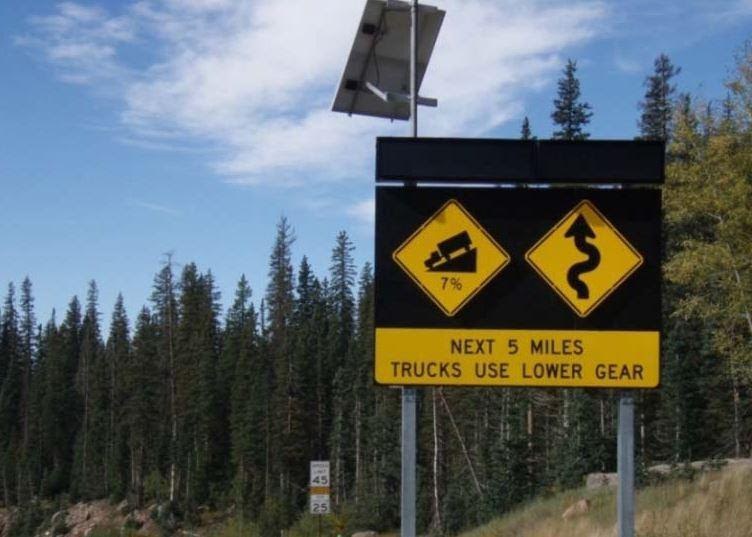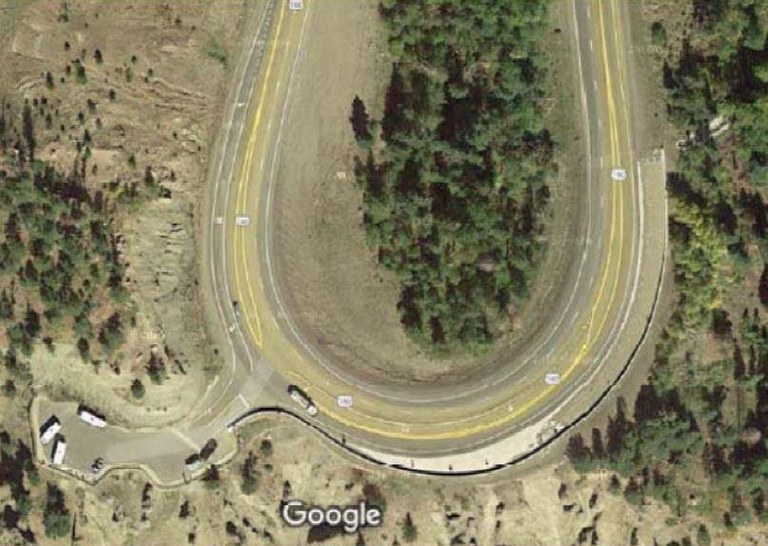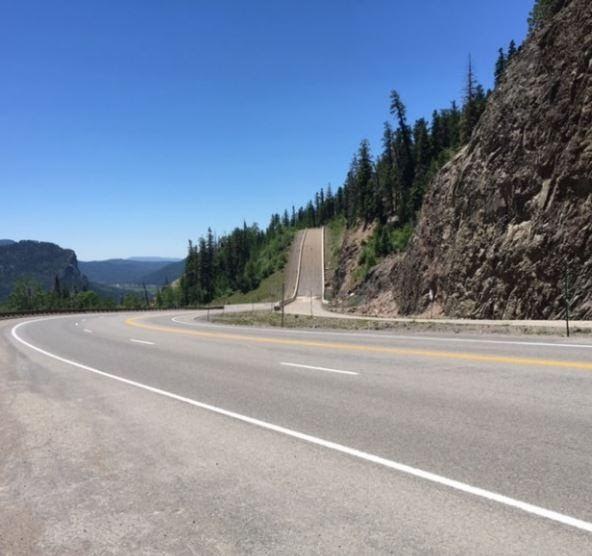CDOT & CSP warn truckers: Beware the Wolf
Travel Advisory

SOUTHWEST COLORADO – When traveling through Colorado’s mountains, semi-truck drivers can encounter challenging and dangerous conditions, especially during winter snow storms. The Colorado Department of Transportation is warning big rig drivers to use extreme caution when traveling over mountain passes, like US Highway 160 Wolf Creek located in the southwest region of the state.
“The number of crashes over the years underscores the need to slow down over this mountain pass,” said Colorado State Patrol Capt. Adrian Driscoll. “From 2015 to 2019, there have been 47 semi-truck crashes on the west side of Wolf Creek Pass. Three of those crashes resulted in needless fatalities.”
CDOT and the Colorado State Patrol are teaming up to conduct safety checks of commercial motor vehicles (CMV) at the summit of Wolf Creek Pass. Safety checks will involve interviewing the driver of the CMV, informing them of the locations of tight turns on the pass, and educating them about the importance of downshifting and maintaining a low speed for the next 7 miles. Printed materials will be available in English and Spanish.
“Stopping CMVs and talking with drivers has proven successful,” added Driscoll. “Past safety checks have coincided with construction projects on the pass. Letting drivers know what they are in for, coming down the pass can prevent a potential crash, so we’re going to pick those efforts up again.”
A 2016 road safety audit provided needed information to CDOT, which helped identify several recent safety enhancements on the pass to improve driver safety and behavior. Improvements included overhead electronic signs, enhanced large warning signs, and increasing the length of the concrete barrier at the scenic overlook. A majority of the crashes occurred at the switchback curve located near the Wolf Creek scenic lookout area.
“This pass can be very deceiving to the traveling public,” said George Hudran, CDOT maintenance foreman for Wolf Creek Pass. “The highway is wide with three and four lanes along some stretches and ample shoulders. Many truck drivers are fooled by these road features, to only find themselves out-of-control once they’ve made it half way down the pass.”
Hudran added, “The drivers of commercial vehicles and heavy trucks should always take time to familiarize themselves with their routes. Knowledge and understanding of our state roadways is extremely important when traversing over mountain passes, especially one like Wolf Creek Pass.”
Wolf Creek Pass Safety Tips

- What is the speed limit? The posted speed limit for traffic traveling westbound, downhill from the summit varies from 25 to 45 MPH. Commercial trucks must maintain the lower 25 MPH speed.
- What is the grade of the pass? The west side of the pass is at a 7% downhill grade.
- What is the distance from the summit to the west base? The distance from the summit (near Wolf Creek Ski Area) to the west base of the pass (near Treasure Falls) is just over eight miles.
- What curves will drivers encounter? A dangerous hairpin curve is located six and a half miles from the summit of Wolf Creek Pass.

Are there public access areas on the pass route? A ski area, forest roads and a public scenic lookout are all points of access along US 160 Wolf Creek Pass in which truckers may encounter other vehicles attempting to enter or exit the roadway.
Where are brake stations, chain-up stations and runaway ramps located?
-
Truck drivers should inspect their brakes at the summit, before descending the eight mile trip down the pass. A wide shoulder area is available to all motorists traveling both west and eastbound. This area can also be used as a chain-up station.
-
Two runaway escape ramps are available for
out-of-control trucks at mile points (MP) 162.5 and 161. (see runaway ramps details below)
Other southwest/south-central Colorado passes include: US 550 Red Mountain, Molas and Coal Bank Passes; Colorado Highway (CO) 145 Lizard Head Pass; CO 17 La Manga-Cumbres Pass; and US 50 Monarch Pass.
Maintain Control
Even the most experienced drivers should practice the utmost caution and safe driving practices to keep control of their vehicles.
- Check brakes before descending the pass.
- Maintain a low speed, in low gear. Use flashers to warn other vehicles of the truck’s low speed.
- Do not “ride” the truck’s brakes. This will cause overheating and possible loss of the brake system.
- Jake Brakes (or compression brakes) can be a useful braking mechanism to help control the speed of a heavy truck. However, the best practice is to remain in low gears to avoid overheating.
- Keep brakes cool by pulling into brake stations or onto the shoulder of the road, if a safe spot can be located.

Runaway Ramps
Two runaway ramps are located on the west side of Wolf Creek Pass for trucks traveling downhill and westbound. These emergency escape ramps are located on the right side of the road and preceded by warning signs at each location. Both are incline ramps.
- Runaway Ramp, MP 162.5 – approximately 4.5 miles from the pass summit.
- Runaway Ramp, MP 161 – approximately 6 miles from the pass summit. This location is a trucker’s last chance to make a decision to use the ramp.
If drivers are forced to use a runaway ramp:
- Maneuver the trucks into the far right lane before approaching upgrade ramps.
- As the truck approaches the runaway ramp, steer straight and try to keep the wheels aligned.
- Ramps are narrow. Attempt to stay in the center of the ramp to avoid any risk of rolling over.
- Once the truck is stopped, call 911 to report the incident, even if there are no injuries associated with the episode.
Never Hesitate
“If a truck driver has lost control, there should never be a hesitation to use the runaway ramps,” Capt. Driscoll emphasized. “If a truck’s brakes fail due to overheating or excessive use going downhill, runaway ramps are the only way the truck will be able to stop."
Driscoll concluded, “Truckers should also consider the load they are hauling. Goods carried on the trucks and in the trailers are essentially the drivers’ income; there should be great concern protecting that commodity. There may be monetary consequences for using a runaway ramp -- potential fees associated with a tow company's removal of the truck from the ramp or perhaps even a law enforcement fine. But not using the ramp can result in the ultimate cost: the irreplaceable life of a driver or the lives of those they share the road with.”
Stay Informed
CDOT provides an abundance of information specifically for the trucking community. Visit CDOT’s website at codot.gov > Travel > Commercial Vehicles/Trucker Information. The page contains tips on preparing for trips, using escape ramps, and knowing details about the pass. A map of Wolf Creek Pass can be seen and a video can be viewed of a commercial semi-truck that burned out its brakes while traveling too fast down the pass. The video is also available on CDOT’s YouTube channel.
Travelers are urged to “know before you go.” Gather information about weather forecasts and anticipated travel impacts and current road conditions prior to hitting the road. CDOT resources include:
- Road conditions and travel information: COtrip.org
- Sign up for project or travel alerts: bit.ly/COalerts
- Scheduled lane closures
- Connect with us on social media: Twitter @coloradodot and Facebook facebook.com/coloradodot
